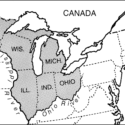In 1787, the Northwest Territory of the United States was a big, wild area. It was ceded by Britain to the U.S. in the 1783 Treaty of Paris, just as Puerto Rico was ceded to the U.S. by Spain in another Treaty of Paris more than a century later.
The Northwest Territory was the first incorporated territory of the United States, but there were some real issues keeping it from becoming a state.
For one thing, it was too big — much bigger than any of the states in existence in 1783. It also still contained British forts and British soldiers. Indigenous people also lived there, and Americans were moving in, even though they were not legally allowed to do so. In fact, several states tried to claim land in the territory to make their states bigger. The mixture of populations in the territory led to violent confrontations. There were no settled areas and no central government.
The U.S. Constitution clearly stated that Congress could make new states, but didn’t offer much more guidance than that. It certainly didn’t provide the kind of detail Congress needed to create states from the Northwest Territory in an orderly way. The Northwest Ordinance was the solution. It was made into law in July of 1787, and provided a model for establishing territories and states from that time on.
The Ordinance stated the intention of the United States to make three to five states out of the Northwest Territory. It listed a Bill of Rights for the Territory. It also laid out three stages on the way to statehood:
- First, Congress would appoint a governor, a secretary, and three judges to serve as the government of the territory.
- Once the territory had 5,000 voters, they could elect an assembly and send a non-voting delegate (like Puerto Rico’s Resident Commissioner) to Congress. Since only men voted in those days, this meant that the population would have to include 5,000 men: women and children didn’t count. The Ordinance also specified that only free men counted, so slaves could not be included in the population total.
- When the territory grew to 60,000 people, the territory could create a constitution and ask for statehood.
Big changes
Before the Northwest Ordinance, the first states of the Union had the idea that they could get more land and grow bigger. Some U.S. leaders saw this as the way to grow the new nation. The Northwest Ordinance settled that there would instead be new states. This is the way that the United States has grown ever since.
The Northwest Ordinance also determined that all new states would enter the Union on an equal footing with the states that already existed.
Slavery was forbidden in the new states, and religious freedom was required. The Ordinance also called for education and required that a new state must have a university.
The Ordinance also included regulations regarding the indigenous population. “The utmost good faith shall always be observed towards the Indians; their lands and property shall never be taken from them without their consent; and, in their property, rights, and liberty, they shall never be invaded or disturbed, unless in just and lawful wars authorized by Congress; but laws founded in justice and humanity, shall from time to time be made for preventing wrongs being done to them, and for preserving peace and friendship with them.” In fact, many of the Native Americans already living in the Northwest Territory did not accept that the land belonged to the United States, and violence continued until the 1800s.
The Northwest Ordinance also settled the question of how people could gain land in new territories. This question had been disputed in the courts for years before the Ordinance determined that people could buy and sell the land.
After statehood
The Northwest Territory was carved into the states of Ohio, Indiana, Illinois, Michigan, and Wisconsin, with a little bit left over to be part of Minnesota.
The Northwest Ordinance created a pattern for adding states to the Union, and encouraged westward expansion. It didn’t set rules for admitting states outside of the Northwest Territory, but it set expectations. As Eric Biber famously wrote in “The Price of Admission,” in the American Journal of Legal History, “Through the admission of thirty-seven new states to the Union (and the readmission of eleven seceded states during Reconstruction), Congress has developed a general process for the admission of new states, albeit a process which is rarely followed precisely in individual cases.”
In 1803, the Louisiana Purchase brought the United States a new territory which would lead to 15 new states, all brought in under the Northwest Ordinance tradition.
No general laws about territories and states have been passed since the Northwest Ordinance.








No responses yet